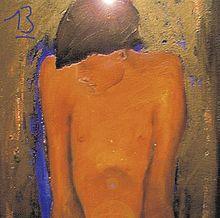
Blur are an English rock band formed in London in 1988. The band consists of singer Damon Albarn, guitarist Graham Coxon, bass guitarist Alex James and drummer Dave Rowntree. Their debut album, Leisure (1991), incorporated the sounds of Madchester and shoegaze. Following a stylistic change influenced by English guitar pop groups such as the Kinks, the Beatles and XTC, Blur released the albums Modern Life Is Rubbish (1993), Parklife (1994) and The Great Escape (1995). As a result, the band helped to popularise the Britpop genre and achieved mass popularity in the UK, aided by a widely publicised chart battle with rival band Oasis in 1995 dubbed "The Battle of Britpop".

Damon Albarn is an English musician, singer, songwriter, multi-instrumentalist, and record producer from Whitechapel, London. He is the frontman and main lyricist of the rock band Blur and the co-creator and primary musical contributor of the virtual band Gorillaz.

Parklife is the third studio album by the English rock band Blur, released on 25 April 1994 on Food Records. After moderate sales for their previous album Modern Life Is Rubbish (1993), Parklife returned Blur to prominence in the UK, helped by its four hit singles: "Girls & Boys", "End of a Century", "Parklife" and "To the End".
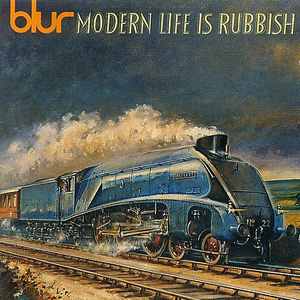
Modern Life Is Rubbish is the second studio album by the English alternative rock band Blur, released in May 1993. Although their debut album Leisure (1991) had been commercially successful, Blur faced a severe media backlash soon after its release, and fell out of public favour. After the group returned from an unsuccessful tour of the United States, poorly received live performances and the rising popularity of rival band Suede further diminished Blur's status in the UK.

Graham Leslie Coxon is an English guitarist, singer-songwriter, multi-instrumentalist, record producer and painter who came to prominence as a founding member of the rock band Blur. As the group's lead guitarist and secondary vocalist, Coxon is featured on all of Blur's studio discography. He has also led a solo career since 1998, producing and playing all instrumentation on his solo albums. As well as being a musician, Coxon is a visual artist: he designed the cover art for all his solo albums as well as Blur's 13 (1999).

Think Tank is the seventh studio album by the English rock band Blur, released on 5 May 2003. Continuing the jam-based studio constructions of the group's previous album, 13 (1999), the album expanded on the use of sampled rhythm loops and brooding, heavy electronic sounds. There are also heavy influences from dance music, hip hop, dub, jazz, and African music, an indication of songwriter Damon Albarn's expanding musical interests.

The Great Escape is the fourth studio album by the English rock band Blur. It was released on 11 September 1995 on Food and Virgin Records. The album reached number one on the UK Albums Chart and charted in the top 10 in more than ten countries around the world. Less than a year after the album was released, it was certified triple platinum in the UK. The album received near-universal acclaim on release.

Blur is the fifth studio album by the English rock band Blur, released on 10 February 1997 by Food Records. Blur had previously been broadly critical of American popular culture and their previous albums had become associated with the Britpop movement, particularly Parklife, which had helped them become one of Britain's leading pop acts. After their previous album, The Great Escape, the band faced media backlash and relationships between the members became strained.

Gorillaz is the debut studio album by English virtual band Gorillaz, released on 26 March 2001 in the United Kingdom by Parlophone and in the United States by Virgin Records. The album reached number three in the UK and number fourteen in the US, and the top ten in several other countries. Gorillaz has sold over seven million copies worldwide. The album's success earned the group an entry in the Guinness Book of World Records as the "Most Successful Virtual Band", and spawned the singles "Clint Eastwood", "19-2000", "Rock the House", and "Tomorrow Comes Today".

Justine Elinor Frischmann is an English artist and retired musician. She was the lead singer of the Britpop band Elastica after forming Suede, before retiring from the music industry and pursuing a career as an artist.
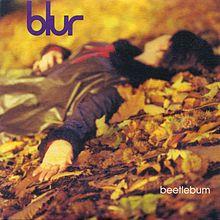
"Beetlebum" is a song by English alternative rock band Blur. It was released on 20 January 1997 as the lead single from the band's eponymous fifth album, Blur (1997). Written about Blur frontman Damon Albarn's experiences with heroin, the song features Beatles-influenced music and a mood that Albarn described as "sleepy" and "sexy". Despite fears of the song's uncommercial nature, the single debuted at number one on the UK Singles Chart, becoming Blur's second track to top the chart. It has since appeared on several Blur compilations.
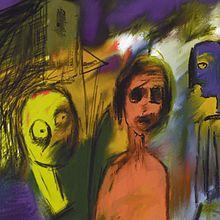
"Coffee & TV" is a song by British rock band Blur. It was written by the band's guitarist, Graham Coxon, who also sang lead vocals rather than frontman Damon Albarn. The song appears on Blur's sixth studio album, 13 (1999), and was the second single released from the album on 28 June 1999. The lyrics describe Coxon's struggle with alcoholism and the song's video, featuring a sentient milk carton searching for Coxon, won several awards. Commercially, "Coffee & TV" reached No. 11 in the United Kingdom and No. 26 in Ireland. It was a major hit in Iceland, where it peaked at No. 2 in September 1999.

"Tender" is a song by English rock band Blur from their sixth studio album, 13 (1999). Written by the four band members about Blur frontman Damon Albarn's breakup with musician turned painter Justine Frischmann, the song was released in Japan on 17 February 1999 and in the United Kingdom on 22 February as the album's lead single. "Tender" became Blur's 11th top-10 hit on the UK Singles Chart, debuting and peaking at number two the week after its release. It also reached the top 20 in Greece, Iceland, Ireland, Italy, New Zealand, Norway, and Spain.
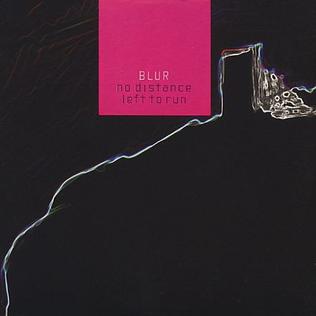
"No Distance Left to Run" is a song by English rock band Blur from their sixth studio album, 13 (1999). It was released as the third and final single from the album on 15 November 1999, reaching number 14 on the UK Singles Chart. It is widely understood to refer to Blur vocalist Damon Albarn's split from long-term partner Justine Frischmann.

Elastica were an English rock band formed in London in 1992 by ex-Suede members Justine Frischmann and Justin Welch. The band was stylistically influenced by punk rock, post-punk and new wave music. The band's members changed several times, with Frischmann and Welch being the only members who remained in Elastica from its formation to its dissolution.

"Girls & Boys" is a song by English rock band Blur, released in March 1994 by Food Records as the lead single from the group's third studio album, Parklife (1994). The frontman of Blur, Damon Albarn wrote the song's lyrics with bandmembers Graham Coxon, Alex James and Dave Rowntree, while Stephen Street produced it.
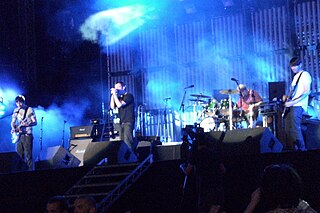
The discography of English rock band Blur consists of nine studio albums, five live albums, five compilation albums, one remix album, two video albums, four extended plays, 35 singles, 10 promotional singles and 37 music videos. Formed in London in 1988, the group consists of singer/keyboardist Damon Albarn, guitarist/singer Graham Coxon, bassist Alex James and drummer Dave Rowntree. Three years later, their debut release, the Madchester and shoegazing-tinged Leisure (1991), peaked at number seven on the UK Albums Chart. Modern Life Is Rubbish (1993) inaugurated the Britpop phase of their career. Its multi-Platinum follow-ups Parklife (1994) and The Great Escape (1995) helped the band achieve mainstream popularity in Britain; every Blur studio album from Parklife onwards has topped the British charts.

"End of a Century" is a song by English alternative rock band Blur. Released in November 1994 by Food Records, it was the last single to be released from their third album, Parklife (1994). The song reached number 19 on the UK Singles Chart, considered a disappointment by Andy Ross of Food. Damon Albarn later stated that "End of a Century" may not have been the best choice for the album's fourth single, and that "This Is a Low" would have been a better alternative.
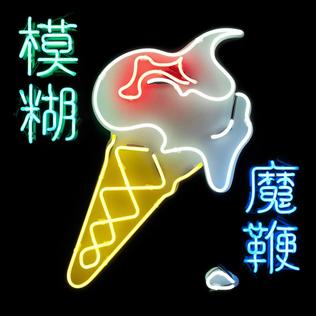
The Magic Whip is the eighth studio album by English rock band Blur. It was recorded in Hong Kong and London, and released by Parlophone on 27 April 2015 and Warner Bros. Records on 28 April 2015. It was the band's first studio album in 12 years since Think Tank (2003), marking the longest gap between studio albums in Blur's career, and the first in 16 years since 13 (1999) to have featured the original line-up. The album also marks the return of the band's longtime producer Stephen Street following Blur (1997).
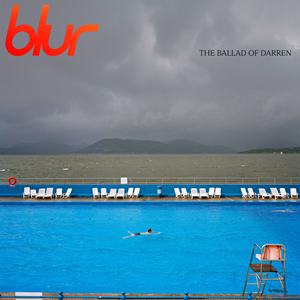
The Ballad of Darren is the ninth studio album by English rock band Blur. It was released on 21 July 2023 by Parlophone and Warner Records. The album's songs were written by frontman Damon Albarn in 2022 while on tour with Gorillaz, and composed by Albarn and the rest of the band. It was produced by James Ford at Studio 13 in London and Devon. It is Blur's first album since The Magic Whip (2015), and their shortest album, with a runtime under 40 minutes. The album's artwork features a 2004 photograph of a man swimming alone in the Gourock Outdoor Pool in Gourock, Scotland, taken by Martin Parr. Its title refers to Darren "Smoggy" Evans, the band's longtime bodyguard.
